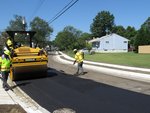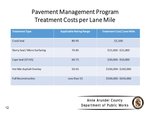 Severna Park
Severna ParkOvercast, 53°
Wind: 9.2 mph, E
 Severna Park
Severna Park





Driving through parts of Anne Arundel County can produce the feeling of a roller-coaster jolt. Potholes make some streets aggravating to traverse and other streets potentially hazardous.
But the Anne Arundel County Department of Public Works is aware of the conditions on county roads. (Ritchie Highway, B&A Boulevard and other state roads fall under the responsibility of the Maryland State Highway Administration).
Anne Arundel County has roughly 1,800 centerline miles to maintain. That measurement represents road distance from beginning to end, without taking into account the size or number of lanes.
Blake Lightcap, a program manager for the Infrastructure Management Division of the Bureau of Highways, has a team of eight workers who do condition assessments, also known as road ratings, for segments that contain those 1,800 centerline miles.
“Every year, one-third of the roads get graded,” Lightcap said. “The methodology we use, we identify 14 different deficiencies that could exist on the roadway.”
Those deficiencies can be found on the road surface or in one of the layers underneath. Ratings range from zero to 100. Just because a road is in bad condition doesn’t mean it will be the next road chosen for repair, Lightcap said. The department uses contactors for all of its work and it prefers cost-effective preventative measures instead of costly reconstruction.
“Once you have to build an entirely new road, it’s not costing any more money,” he said. “Those roads might get more potholes, more alligator cracking, but they won’t get any more expensive to fix. If a road is in good shape, it’s inexpensive to keep the road healthy.”
The Department of Public Works has calculated that $26 million annually is needed to stop adding to the road maintenance backlog and $42 million annually is needed to eliminate the backlog over 10 years and stop adding new backlog.
To illustrate his point about good roads being less expensive to repair, Lightcap shared the county’s different approaches to road maintenance.
Crack sealing is applied to roadways to prevent water penetration. That method, usually used on roads rated from 80 to 95, costs an average of $1,500 per lane mile. Slurry seal or micro-surfacing uses liquid asphalt to seal cracks. Used for roads in the 70 to 85 range, it costs an average of $15,000 to $25,000 per lane mile. As those two examples demonstrate, there is some overlap between ratings and methods.
A two-part treatment, cape seal applies tar and chip (liquid asphalt and small stones used to fill cracks) followed by a slurry seal or micro-surfacing to provide improved skid reduction and seal the road surface. That method costs an average of $30,000 to $50,000 per lane mile and is used primarily for roads rated from 60 to 75. Lastly, full reconstruction can involve the replacement of roads, sidewalks, curbs and gutters, costing the county an average of $500,000 to $650,000 per lane mile.
“With sound pavement management, it is not a worst-first approach,” Lightcap said. “We would be using this [road construction method] on everything and blowing through our budget.”
Lightcap said the county fixes approximately 75 percent of the mileage with 25 percent of its budget.
“Whether it’s wastewater treatment plants or roads, with all of our assets, we want to manage them as fiscally responsible as possible while still maintaining the environment,” said Matt Diehl, a spokesperson for the Department of Public Works.
Roads are in a constant state of deterioration because of use and weather. Potholes form when water seeps below the pavement. Lightcap said Anne Arundel County roads are hot mix asphalt, “which is nothing more than big stones, small stones, a sand mix, and a liquid asphalt, like tar.”
He said 92 to 97 percent of the roads are sealed, which leaves 3 to 8 percent of space. “Water infiltrates those spaces, those soil particles begin to float, it freezes and expands,” Lightcap said.
The asphalt is forced up and then it sinks when the water thaws, creating a spot that is vulnerable to crumble when vehicles make contact.
Roads also worsen from sun exposure. “If you leave anything made of plastic in the sun, it degrades,” Lightcap said. “It’s the same thing with our roadway.”
Colchester, Linstead and Round Bay have received preventative maintenance in 2018 while part of Evergreen Road is due for resurfacing in 2019.
It takes about one month for a road to fully cure. In the meantime, the Department of Public Works sends sweepers to clean debris.
“Once we leave, it doesn’t necessarily mean it’s a complete project,” Diehl said. “It’s going to improve.”
To request information about a road in your community, call the Infrastructure Management Division at 410-222-4349.
“We want to educate people about the decisions we make,” Lightcap said. “We’re not just throwing darts at the board. There is a system in place and it’s functional.”
Comments
No comments on this item Please log in to comment by clicking here